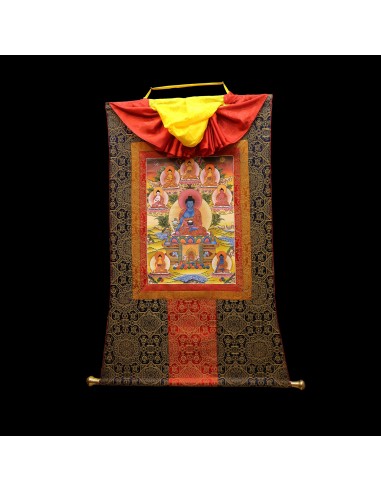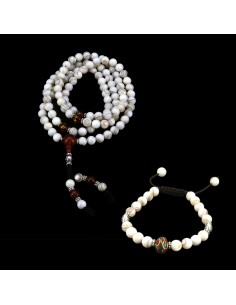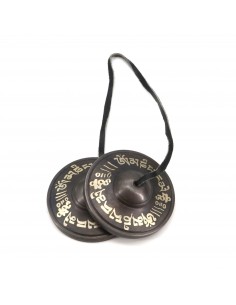11"x11" Kalachakra Mandala Thangka Painting
This thangka was painted by a master thangka artist in the traditional style, and it is of high quality.
| Name | : Kalachakra Mandala Thangka Painting |
| Mantra | : 'Om Ham Ksha Ma La Va Ra Ya' |
| Dimension | : 33"x22" inches approx. (With Brocade) |
| Dimension | : 11"x11" inches approx. (Without Brocade) |
| Color | : Mineral, and vegetable pigment |
| Material | : Cotton Canvas, and Gold Plated Detail |
| Design | : Buddhism and Tibetan Thangka Painting |
| : Wall Hanging OR Frame Home Decor | |
| Origin | : Handmade in Nepal |
| Time to Make | : Ready to Ship |
The Kalachakra mandala is a complex and intricate symbol that plays an important role in the Kalachakra Tantra, a Buddhist scripture that emphasizes the concepts of time, cycles, and the union of wisdom and compassion. The word "mandala" comes from Sanskrit and means "circle," and it is often used to describe circular or geometric patterns that are used in spiritual practices. The Kalachakra mandala is a three-dimensional representation of the universe according to the teachings of the Kalachakra Tantra. It is typically depicted as a circular diagram with a central palace surrounded by four walls, with a series of concentric circles and squares that radiate outwards from the center. The palace at the center of the mandala is known as the "mandala palace" and is believed to represent the pure land of the Buddha. The outermost circle of the mandala is called the "boundary of fire," and it is said to symbolize the fire that burns away ignorance and negative emotions. The next circle inwards is called the "boundary of thunderbolt," and it represents the powerful and transformative nature of the Kalachakra teachings. The third circle inwards is the "boundary of lotus," which symbolizes the purity and clarity of the mind. Finally, the innermost circle is the "boundary of the diamond," which represents the indestructible nature of the enlightened mind. Within the mandala palace, there are a series of intricate and interconnected chambers and corridors that represent the different aspects of the Buddhist path. These chambers are adorned with various symbols and deities, each of which has a specific meaning and purpose in the practice of the Kalachakra Tantra. The Kalachakra mandala is used in a variety of ways in Buddhist practice, including as an aid to visualization and meditation. By visualizing the mandala and its various elements, practitioners aim to cultivate wisdom and compassion and gain a deeper understanding of the nature of reality. In some cases, the mandala may also be used in ritual practices, such as the construction of sand mandalas or the creation of torma offerings.
The Kalachakra mandala is a powerful symbol that encapsulates the complex teachings of the Kalachakra Tantra. It's intricate design and rich symbolism have made it an important part of Buddhist art and culture, and it continues to be used by practitioners around the world to this day.
-----------------------------------------------------------------------------------------------------------------------------------------------
* Thangka's Border (Tibetan silk brocade) can come in a variety of colors and patterns.
Note: The actual color of the products may slightly differ due to the photographic edits.




































